Sleeping with wolves: a suburban adventure
To show coexistence is possible, campers and wild wolves spend the night side by side under the stars
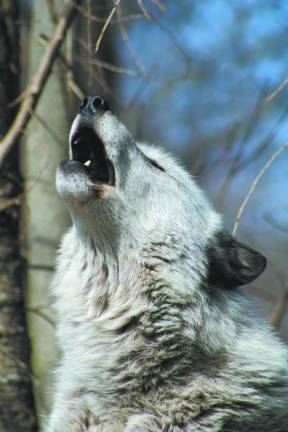
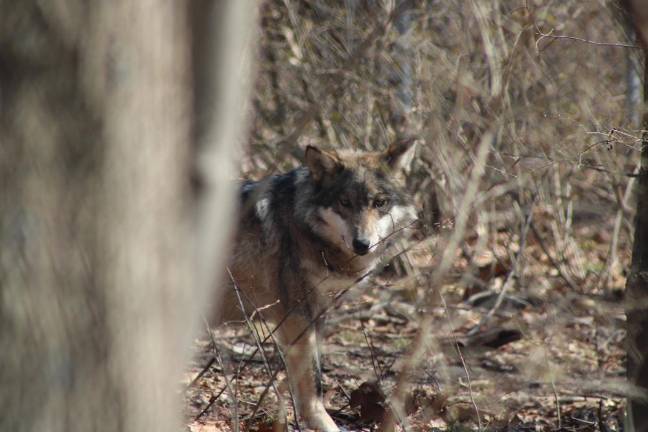
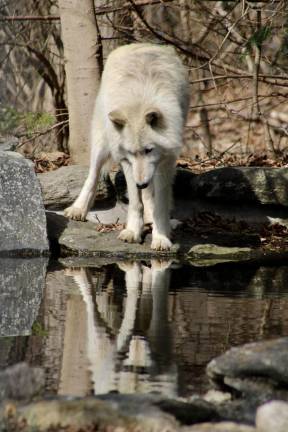
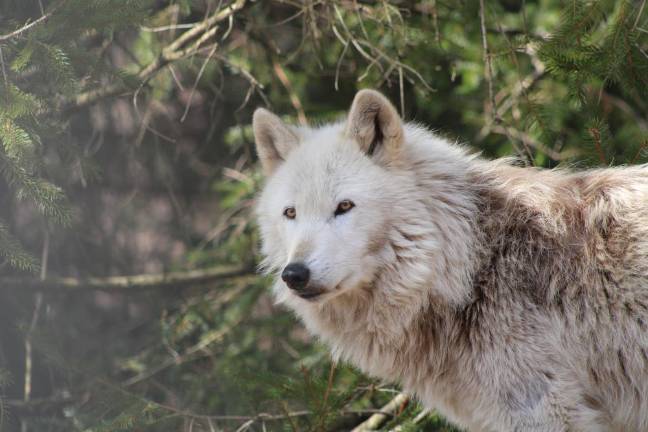
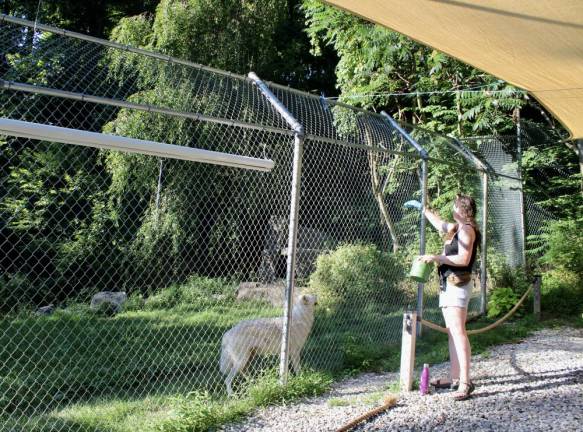
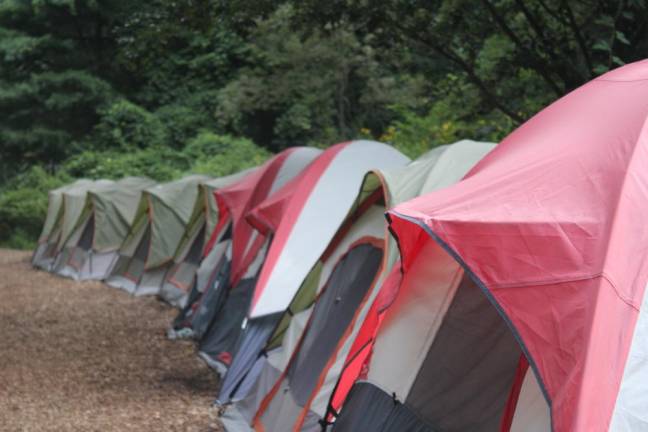
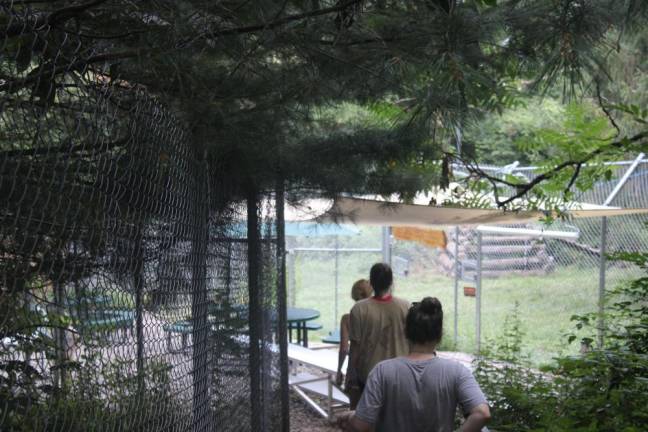
As thirty-plus wolves howl outside my tent, I reassure myself as a vegetarian I will likely be the last meal choice. The howling started off as a single siren-like sound that cut through the nighttime whirs, cracks, and hums of the late July woods of South Salem, New York, then swelled into a cacophony of feral music. The midnight chorus slowly ebbs until the croaks of bullfrogs and rustling trees take center stage once more.
Curled in my sleeping bag, I imagine the wolves around me with their heads in furry paws, eyes half closed in their darkened dens. In such proximity to their wildness, I’m surprised how safe I feel under the protective bubble their howls carve out of the dark.
The wolves reside at the Wolf Conservation Center, self-dubbed “New York’s version of Yellowstone.” I arrived at the center, tucked away at the end of a near-vertical driveway complete with potholes on one side and a steep drop-off into a wooded ravine on the other, with three friends. To my surprise, they had needed little convincing that sleeping with wolves was a good idea. As we stepped out of the car, the quiet of the woods was an instant relief from the noise and stifling heat of New York City we left a little over an hour before.
We grabbed our bags and walked up a mulched pathway to a row of four-person tents set up on the walkway to the wolf enclosures, whose chain link fencing is visible here and there through the surrounding greenery. Built on a hill in the sparsely inhabited Westchester County hamlet, the nonprofit center was founded in 1999 by French classical pianist and wildlife conservationist Hélène Grimaud. Its aim is to prevent the extinction of wolves through education, captive breeding and recommendations for reintroduction. The center is funded primarily through individual donations and educational programming, like the popular sleeping with wolves program that runs weekend nights from May through October ($150 for singles, $299 for a four-person group). It has built a global support base through its interactive social media and popular webcams that live stream the wolves.
With our sleeping arrangements settled, we headed over to the sloping lawn above the gift store. Once everyone has gathered, Wildlife Outreach Specialist Dana Goin led us up to the enclosures.
The first enclosure hosts the “ambassador wolves.” The group troops through the main entrance and takes seats at benches and tables facing the tall chain link fence. On the other side, two white-coated gray wolves, Alawa and Nikai, rest under the trees. The ambassador wolves are bred in captivity for educational purposes, explains Goin, and as a result are comfortable around humans. The other wolves here have a chance of being reintroduced into the wild, so the center prioritizes safeguarding their natural behaviors. “If they go up to people thinking, ‘Hey buddy let’s be best friends,’ they’re probably not going to get very far,” said Maggie Howell, executive director of the Wolf Conservation Center, whom I met earlier in March. Human interaction with the wolves is therefore limited to the necessities.
While the ambassador wolves are fed and have three acres to roam, Howell says living in captivity isn’t ideal for any animal. They lack the freedom and interactions animals have in the wild. “It’s heartbreaking because you’re happy you’re able to offer a sanctuary,” said Howell. “At the same time, you’re like, ‘Wow, you were in a place without fences.’” The center provides “enrichment” for the ambassador wolves, Goin explains, by giving them boxes with unusual smells like snakeskin and horsehair; organizing “Easter egg hunts” through their summer camps where the wolves are moved to a different enclosure and campers will hide treats for the wolves to uncover; and feeding them snacks like chicken popsicles. One such snack is near Goin’s feet in a green bucket. She puts on a blue rubber glove, opens the bucket of raw turkey, and the wolves trot over. As she hurls the “turkey bombs” over the fence, Goin explains the challenges facing wild wolves and why educating people is so important for the survival of the species.
Political animals
Wolves today are on precarious footing, caught on the front lines of a national fight over wildlife management as farmers, ranchers and hunters struggle to coexist alongside the predators. Conservationists advocate for the protection of wolves as an essential keystone species in a healthy ecosystem, while farmers and trophy hunters have resumed the tradition of “harvesting” the recovering populations for sport or to diminish the threat they pose to livestock. This year on the Montana border, a record one-fifth of wolves that roamed outside Yellowstone National Park’s jurisdiction were shot by hunters. Gray wolves were recently relisted as an endangered species in February, after being taken off by the Trump administration in October 2020. They now receive federal protection nationwide, except for the Northern Rocky Mountain population located in Montana, Idaho, and Wyoming, where, after reintroduction of trapped Canadian wolves, the population has recovered from virtual extirpation to an estimated 1,900 by 2020. In 2021 conservative lawmakers in those states seized wolf management authority from wildlife professionals and radically liberalized wolf trapping and hunting regulations.
“Wolves are political animals,” said Howell. To make the situation more complicated, hunting wolves brings in significant revenue for many states through hunting licenses and the purchasing of guns.
Alawa and Nikai gobble up the turkey, sprinting quickly in all directions to scoop the falling pieces out of the air as visitors snap pictures. When they have satisfied themselves that all the snacks are gone, the unwitting ambassadors trot off into the trees. Goin leads us up another path into the acres of wolf enclosures currently hosting nine red wolves and 22 Mexican gray wolves. The Wolf Conservation Center is a partner in the Species Survival Plan, a federal recovery program for both species, which were at one point extinct in the wild. The program aims to keep the species alive through carefully managed captive breeding. Each enclosure at the center hosts one or two wolves, the latter in mating pairs determined to be suitable genetic matches – if all goes well, the parents of the future of the species.
Wolves in the Species Survival Plan are tagged with GPS tracking devices so researchers can record their movements, pack territories and breeding. Each of these wolves is given an identification sequence, an M or F for male or female, followed by a series of numbers. At the Wolf Conservation Center, each wolf also has a name.
At the red wolf enclosure, we investigate the thick green undergrowth but don’t see any movement. The enclosure is home to Tyke (M2118) and Lava (F2134). When the two wolves were placed together, the pair did not get along. The “arranged marriages” don’t always work out, but Tyke and his mate finally started breeding this year.
Strength in the pack
As we head up to the abutting gray wolf enclosure, Goin explains breeding pairs often form strong “pair bonds,” and wolves are known to mate for life. The inhabitants of the gray wolf enclosure, Diego (M1059) and Valentia (F1538), were paired before they found out Diego was sterile. He was separated from Valentia last year in the hopes of artificially inseminating her or placing her with another mate. Divided by a fence, the pair would walk back and forth with each other along the barrier, leaving tracks of footprints in the snow. They would even drag their food over to the fence to eat together. Finally this year they were reunited, placed back in the same enclosure.
“It just shows how strong those bonds are,” said Howell. “Wolves are fascinating because they have so much in common with people.” Family is essential to wolves. They live in cooperative social groups called packs, which are often multigenerational, with older wolves and one-year-olds sharing the responsibilities of hunting and caring for young pups. Wolves’ demonization in popular culture is rooted in the fear of the creatures originating from European settlers. Fairy tales like Little Red Riding Hood and The Three Little Pigs, myths about werewolves, phrases like “lone wolf” and “alpha wolf” depict wolves as single, dominant and violent predators. This narrative is far from reality. “They’re definitely in need of some PR help,” said Howell.
With no sightings of either of the wolf pairs, we head back down to the first enclosure for a classic sleepover fixture: the pizza party. Because of the heat, they’re probably lazing in their dens, explains Goin. While we eat, the trees deepen into silhouettes and fireflies flash electric, and the wolves – crepuscular creatures, most active at dawn and dusk – begin to howl.
Wolves howl to find a mate, as a rallying call to gather their family, to advertise their territory, and as a defensive strategy; if they howl together it sounds like more wolves are present. Howling is also a way for wolves to bond through what Howell describes as social glue. “It’s the same way people sing together. It comes down to bonding and cooperative communication. Teamwork is necessary for survival because a wolf’s strength is the pack,” said Howell.
As the woods settle into night, a projector is set up for another sleepover tradition, a harrowing movie. We watch The Rise of the Black Wolf, a National Geographic documentary about a wolf making his unorthodox way in the wilds of Yellowstone National Park, while the white flashes of Alawa and Nikai slink through the growing darkness behind the fence. Post film, we head up to the campfire for s’mores, our voices blending over one another as we turn marshmallows on sticks. I can’t help thinking about how our laughter must sound to a wolf’s ears. The incoherent cackling might even sound like howling.
I open my eyes at 6 a.m. to the yips of waking wolves. After a light breakfast, we head up to the enclosures to see our canine companions. In between the trees we see Tyke and Lava sitting together, their ears swiveling as a group of kids runs along the fence to catch sight of the elusive creatures.
Sitting with the two red wolves in the morning woods, I think about what coexistence might look like. Could humans and wolves develop a sustainable relationship, based on mutual respect and symbiosis? So much of our response to wolves has been kneejerk, lacking in consideration or close observation of the creatures themselves.
We say goodbye to the wolves and head back down to the tents. As we pack up our sleeping bags, a single howl sounds through the woods. Another howl follows, and soon the woods are alive once more with the baying serenade that rises and falls, reverberating through the trees.